new kid on the conglomerate art block
sophia kouyoumdjian, cementa 2013, kandos, nsw
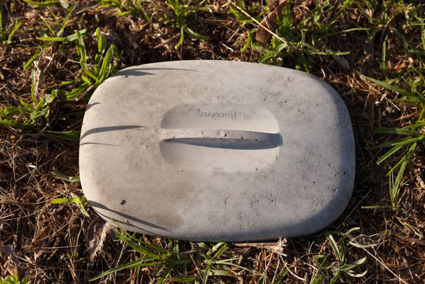
Connie Anthes, Untitled (98 vacancies) (2013)
photo Brett East
Connie Anthes, Untitled (98 vacancies) (2013)
BIENNALES, ART FESTIVALS, ART FAIRS AND ART MONTHS ARE CONSTANTLY PRESENTED TO US AS CONTEXTUAL FRAMEWORKS FOR CONTEMPORARY ART CONSUMPTION. THESE DIVERSE CULTURAL EVENTS, MOSTLY LARGE IN SCALE AND CONCEPTUALLY AMBITIOUS, SERVE TO CONGLOMERATE OUR ART-GOING EXPERIENCES.
Cementa 13, a new kid on the conglomerate block, took on-board this experimental premise with a critical tongue-in-cheek approach. We have all heard of Documenta and Monumenta and now, in Australia anyway, we have Cementa. And here lies the key. Unlike the others, Cementa is firmly located within a social and site-specific context that debunks the white-cube-washing of contemporary art.
Presented by Kandos Projects under the directorship of Ann Finnegan, Georgina Pollard and Alex Wisser, Cementa’s exhibiting artists were invited to undertake residencies in the town of Kandos to develop their works. This residency model resulted in a range of works that not only connected site-specifically, but also with the community and the town’s distinctive character. Works were presented over four days in disused community buildings, empty shopfronts, people’s backyards, on the streets and even the local golf club.
Kandos, over 200 km northwest of Sydney, was certainly not on my regional road-trip radar until I heard the chatter about Cementa at arts gatherings around Sydney. Spurred on by the word-of-mouth build-up as well as the large and impressive list of participating artists I committed to a three-day stay for Cementa.
memorials
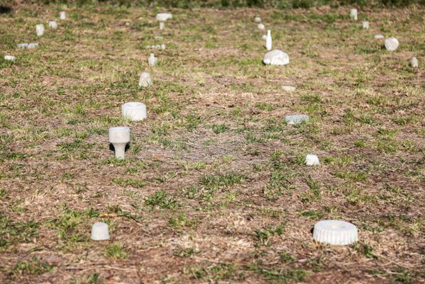
Connie Anthes, Untitled (98 vacancies) (2013)
photo Brett East
Connie Anthes, Untitled (98 vacancies) (2013)
Heading straight out for a walk around town led me to Connie Anthes’ work Untitled (98 vacancies) (2013). In late 2011, Kandos’ main industry—the local cement works and limestone quarry—was decommissioned, inevitably impacting on local economies and the community’s social fabric. In an attempt to memorialise this change, Anthes collected a range of discarded domestic objects from the local tip. Everyday useful items, seemingly no longer needed, were rescued and re-cast in cement. Placed outdoors on the ground of a vacant lot, the meticulous grid of familiar objects became less familiar, disguised by the sameness of their new grey concrete appearance. Like miniature monoliths in the grass, Anthes’ objects invited us to question the everyday effect of industrial change in a rural town.
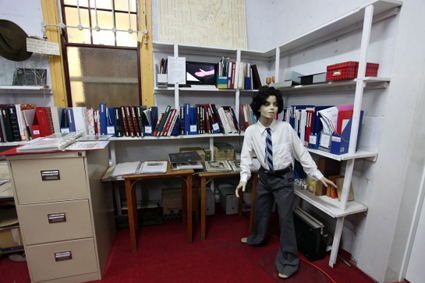
Fiona Davies, Cane (2012)
photo Fiona Davies
Fiona Davies, Cane (2012)
Another work boldly entered the emotionally charged realm of memorialisation within a community context. In her video work Cane (2012), Fiona Davies asked Kandos locals to reflect on school punishment. With the video frame tightly focused on each person’s palm as they recounted punishment by cane in conversation with the artist, we see the hand open, not waiting for punishment but as a marker of memory. Placed beautifully in the Kandos Museum (an Instagrammers heaven), the work sits well amongst a bountiful archive of Kandos’ history. The responses from the participants to their canings range from ‘deserved’ to ‘resented’ and the work brings to light what is mostly amiss in such museological spaces—the personal voice informing the collection’s significance.
intercessions
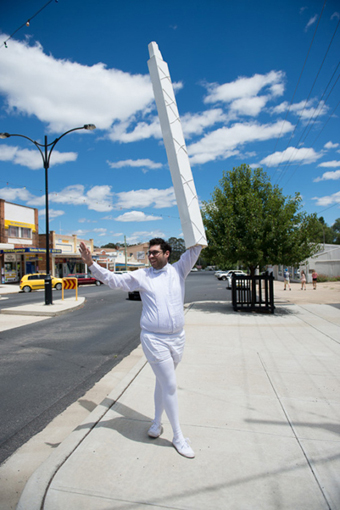
David Capra, Intercessions, Kandos (2013)
photo Alex Wisser
David Capra, Intercessions, Kandos (2013)
Heard loud and clear as he shimmied down the streets of Kandos, artist David Capra continued his investigations into live intercessory performance. Dressed head-to-toe in white, Capra’s outfit intentionally evoked the holy as well as the ubiquitous white of exhibition walls. With an untrained operatic voice and moves that are certainly not trending in contemporary dance studios, Capra’s performance of speaking-in-tongues, banner-waving and dancing became a conduit for intuitive intercession. Unrehearsed and unable to be replicated, his absurd performances on the streets of Kandos were unique experiences of undefined communication and spirit.
During his Kandos residency, Capra was also asked by the Cementa directors to paint the Cementamobile—a handy white van used to cart artists and objects around town. Avoiding a well-trodden path to painterly over-statement, Capra denied the van canvas its loud voice. With sparse, minute motifs on the van—banners, hands shaking and his dachshund Teena—Capra’s van mural was an extremely restrained work. From a distance, the work was indistinguishable. Up close, the motifs came to life in charged patterns Memphis style, an aesthetic born of 1980s post-modernist rejection. Not so coincidentally, the van had a practical role to play in Capra’s performances around town.
serenades
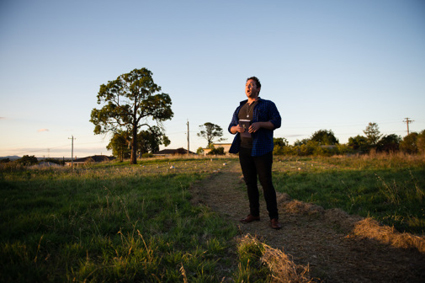
Liam Benson, Cementa (2013)
photo Alex Wisser
Liam Benson, Cementa (2013)
From Hobart Hughes to Sarah Goffman, Cigdem Aydemir and Liam Benson, it was not hard to catch live performance in Kandos. Self-confessed contemporary art romantic, Liam Benson’s daily sunset and sunrise serenades were emotional homages to the Kandos landscape and community. During his residency, Benson developed an affection for the local Glossy Black Cockatoos. Indigenous to the area and with a haven nearby at the Wollomi National Park, the cockatoos are very visible Kandos locals.
Over the four days of Cementa, inspired by the cockatoo’s forlorn call, Benson continued his investigations into masculinity and Australian identity by performing songs of longing and love across Kandos. Singing alone and a capella, each performance’s location unannounced, Benson’s strong rock-infused vocals could be heard emerging from the uniquely Australian local landscape. A sunset performance outside the main pub lured art-goers and locals who followed Benson singing and walking against the backdrop of the dipping sun. As darkness encroached we listened to his rendition of Fleetwood Mac’s “The Chain,” a song about love gone wrong; “Listen to the wind blow, down come the night, running in the shadows, damn your love, damn your lies.”
When not drawing a crowd, Benson sang to Kandos, to an escarpment, a lake, a lone shiftworker in hi-vis clothing, a sleepy campsite and, underlining the ephemerality of performance, to the Glossy Black Cockatoos.
burn-outs
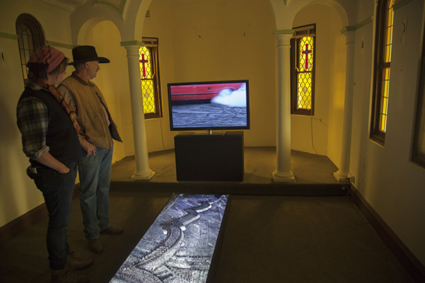
Josephine Starrs, Leon Cmielewski, Chapel of Rubber (2013)
photo Josephine Starrs
Josephine Starrs, Leon Cmielewski, Chapel of Rubber (2013)
Performances of a different kind were the subject of Chapel of Rubber (2013) by Josephine Starrs and Leon Cmielewski. Poetically placed in the now disused chapel at the Kandos Presbytery, the work documented a significant date on the local calendar, the annual Kandos Street Machine and Hot Rod Show. Incongruous with the quiet beauty of the town, this popular but also controversial event is characterised by excessive noise, burn-outs and fluoro cars.
Starrs and Cmielewski’s screen-based work, framed by the intimate architecture of the small chapel, directed our eyes not to the cars, but to the ground—to the spinning tyres and burning rubber. Shot at low-level and in slow-mo, the creeping movement of rising smoke travelled across the screen, at times revealing heavy deposits of burnt rubber on the ground, layered markings of excess, of thrill and of the town’s people and visitors letting go a little. In a town undergoing post-industrial transformation, Chapel of Rubber redefined the strongly symbolic chapel space, maintaining its sense of worship and reverence by channelling hedonistic thrill-seeking action.
There is no doubt there was a lot to conceptually consume at Cementa. At the same time, the incidental social atmosphere—constantly bumping into Sydney-siders and locals while walking along the main drag or grabbing a coffee at the Railway café—meant that Cementa was enjoyably easy to consume. As a conglomerate art experience, the event inhabited the nooks and crannies of Kandos, injecting contextual soul into contemporary art and making it part of the everyday in a rural town. Here’s hoping Cementa 2015 comes around quickly, so we can all get on-board the contemporary art road trip to Kandos.
Cementa 13, directors Ann Finnegan, Georgina Pollard, Alex Wisser; Kandos NSW, Feb 1-4, for participating artists and some great documentation see cementa13.com/
This article first appeared as part of RT’s online e-dition April 3, 2013
RealTime issue #114 April-May 2013 pg. 55






